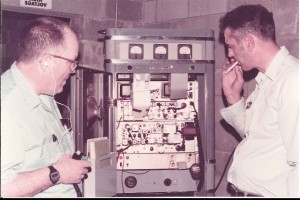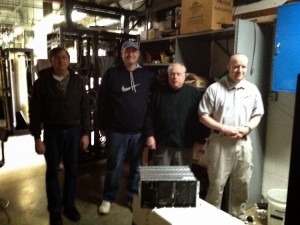
 The Metropolitan Repeater Association (MRA) is chartered as a nonprofit
The Metropolitan Repeater Association (MRA) is chartered as a nonprofit
corporation by the State Corporation Commission under Virginia law. The MRA’s mission is to own, operate, and maintain repeaters supporting the amateur radio community. The MRA was established in 1981 and deployed it’s first VHF repeater, W4SQT (now known as KG4MRA) on March 6, 1982. The W4SQT repeater has been in continuous operation and is located at the WRLH tower in Midlothian, Virginia.
The MRA’s VHF repeater has evolved over the years The latest repeater was a
General Electric Mastr II station controlled by a CAT 1000B controller. The Mastr II has served the MRA well! As technology has evolved, so has the amateur radio community. There are now many types of digital technology commonly available to the average ham: P25, DMR, NXDN, System Fusion, and DStar for example.
The MRA decided at a 2013 board meeting to explore options to expand, enhance,
and benefit the amateur radio community. There were a few constraints mentioned and
diligently followed:
● Do not duplicate existing functionality in the coverage area meaning
we don’t need
another 2m/70cm FM repeater!
● Try to be thrifty!
● Minimize tower climbing if at all possible
● Add functionality that does not exist in the coverage area
● Consider the cost impact upon an average amateur radio operator
A small team of MRA members began researching the available modes, bands,
and cost impacts. The MRA team was presented with an option which met all of the
constraints of the MRA board a Motorola Quantar VHF, multimode (P25/FM) repeater. The Quantar would allow the existing infrastructure to remain intact no tower climbs, no recabling, duplexer reuse and added an additional capability (P25) which did not exist within the coverage area! While one may argue that new P25 equipment is not cheap (and that is a fair argument!), used, reasonably priced equipment can be commonly found on eBay. A Motorola XTS3000, which is P25 and FM capable, can be purchased for approximately $250. A used XTS3000 is half the cost of a DStar ID51 ($515) and 60% of the cost of a Yeasu FT1DRB ($400). Again, while not “cheap”, certainly in the range of reasonable for digital gear.
Additionally, there is a lot of interesting P25 activity in the Software Defined Radio
(SDR) world. Some enterprising amateurs have developed a software suite which can
decode P25 digital packets for under $100. Check http://op25.osmocom.org/trac/wiki for
more information. Again VERY experimental, but isn’t experimentation part of the
amateur radio community spirit?
The MRA board agreed in March, 2014 to replace the existing GE Mastr II with the
Motorola Quantar. The Quantar was acquired, configured, and deployed on March 28,
2014. There was an initial week of “FM only” testing; used to ensure the coverage would
be equal or better than the prior repeater. P25 mode is permitted on April 4, 2014. Multi
mode P25/FM was now fully available to the amateur radio community within the MRA
repeater’s coverage area!
The repeater installation crew (from Left to Right): N4MW, K8OI, WB4KXS, KD4BPZ) not
shown KD4RJN. The Quantar is in front! If you are ever driving up/down I95
through Richmond, VA give a CQ on 145.430pl 74.4 FM or P25!
73 de K8OI
Jim Bates
